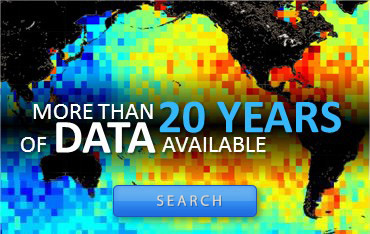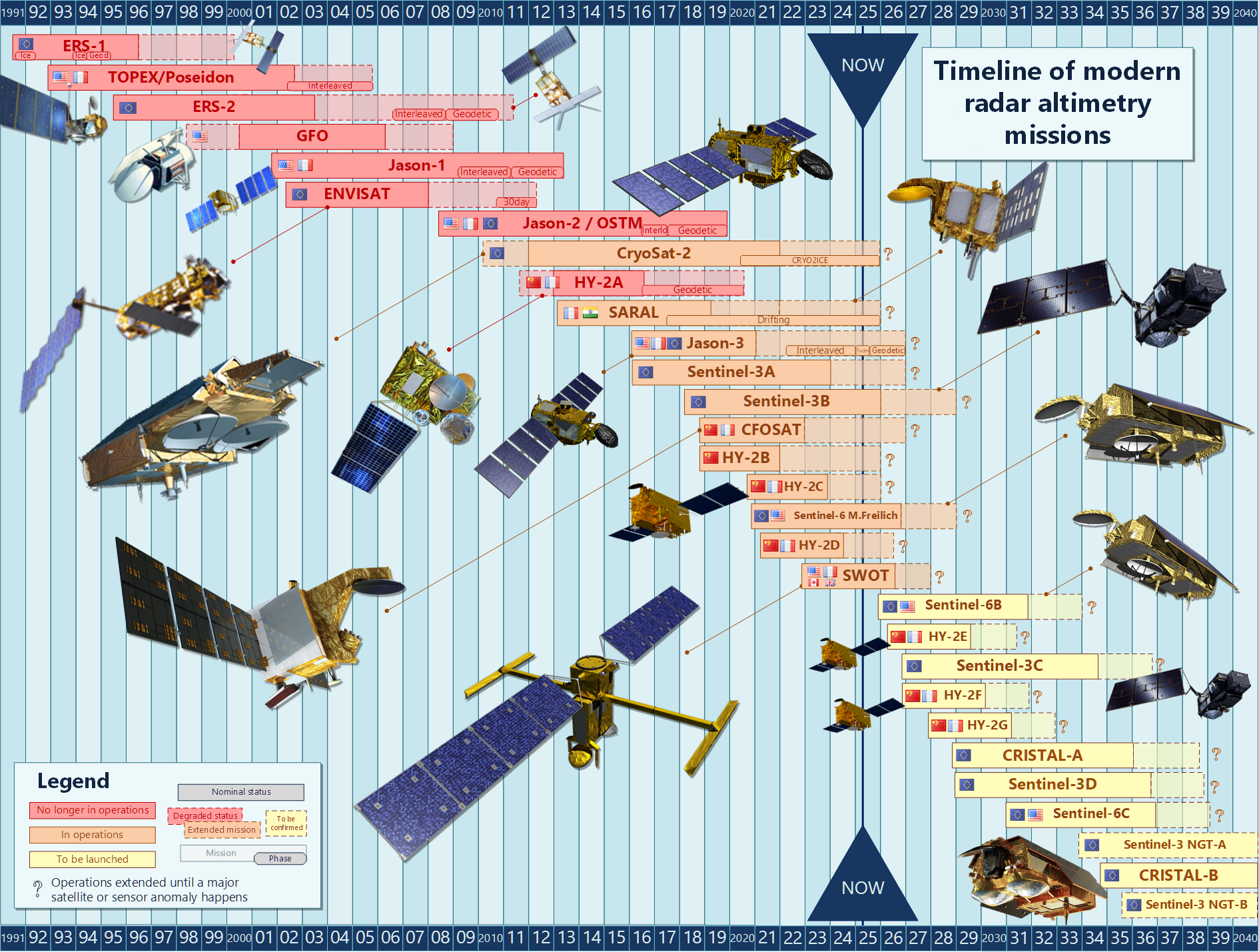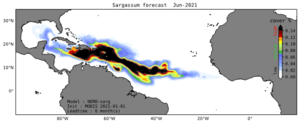Sargassum Seasonal Forecast
Type of dataset: monthly maps of mean sargassum surface cover
Digital Object Identifiers (DOIs):
- Sargassum Seasonal Forecast : 10.24400/527896/a01-2025.002 - more metadata
Condition of access: This product is distributed by AVISO under standard AVISO+ license agreement.
Use: study the seasonal variability of the sargassum biomass in the Tropical Atlantic from Gulf of Guinea to Gulf of Mexico. Anticipate sargassum concentration and areas affected by Sargassum events in the coming months.
Description: The historical Seasonal Sargassum Forecast relies on the system described by Jouanno et al. (2023), operated by at the Laboratoire d’Etude en Géophysique et Océanographie Spatiale (LEGOS) and developed within ANR FORESEA and TOSCA SAREDA projects. This system relies on a mechanistic model of Sargassum populations, the NEMO-Sarg 1.0 model (Jouanno et al. 2021,2023, 2025), which integrates both transport and a physiology model of the macroalgae. The ensemble version of the Sargassum model at 1/4° horizontal resolution has been implemented and allows for the production of 7-month forecasts every month, initialized from Sargassum areal coverage near-real time estimates from the Moderate Resolution Imaging Spectroradiometer MODIS (Berline & Descloitres, 2021).
The operational Seasonal Sargassum Forecasts (September 2025 – on going) are produced globally by Mercator Ocean International, building on the same mechanistic NEMO-Sarg 1.0 configuration (Jouanno et al., 2021, 2023, 2025, see details in 2.1). Sargassum biomass is initialized each month using near-real-time estimates derived from OLCI satellite observations (DOI: 10.24400/527896/a01-2022.007), providing an up-to-date representation of surface concentrations. This global operational framework thus complements the IRD regional setup and extends forecasting capability across the entire Atlantic basin. More details on both processing are available in the user manual.
Geographic coverage: historical dataset: Latitude -15.00 to 50.00, Longitude -100.00 to 15.00; operational dataset: global
Citation: Any use of this dataset must be verified in the AVISO+ license and must cite its DOI 10.24400/527896/a01-2025.002 as well as the following sentence:
- For historical dataset: “The Sargassum Seasonal Forecast product has been produced by IRD with support from CNES, distributed by Aviso+ (DOI 10.24400/527896/a01-2025.002)”
- For operational dataset: “The Sargassum Seasonal Forecast product has been produced by Mercator Ocean International with support from CNES, distributed by Aviso+ (DOI 10.24400/527896/a01-2025.002)”
Ressources:
- User manual
- The code and a set of forcing are freely available on Zenodo (https://www.zenodo.org/record/4275901).
- Jouanno, J., Morvan, G., Berline, L., Benshila, R., Aumont, O., Sheinbaum, J., & Ménard, F. (2023). Skillful seasonal forecast of Sargassum proliferation in the Tropical Atlantic. Geophysical Research Letters, 50, e2023GL105545. https://doi.org/10.1029/2023GL105545
- Berline, L., & Descloitres, J. (2021). Cartes de répartition des couvertures de Sargasses dérivées de MODIS sur l'Atlantique [Dataset]. AERIS/ ICARE - CNES/TOSCA. https://doi.org/10.12770/8fe1cdcb-f4ea-4c81-8543-50f0b39b4eca
- Johnson, S. J., Stockdale, T. N., Ferranti, L., Balmaseda, M. A., Molteni, F., Magnusson, L., et al. (2019). SEAS5: The new ECMWF seasonal forecast system. Geoscientific Model Development, 12(3), 1087–1117. https://doi.org/10.5194/gmd-12-1087-2019
- Jouanno, J., & Benshila, R. (2020). Sargassum distribution model based on the NEMO ocean modelling platform (0.0) [Software]. Zenodo. https://doi.org/10.5281/zenodo.4275901
- Jouanno, J., Benshila, R., Berline, L., Soulié, A., Radenac, M. H., Morvan, G., et al. (2021a). A NEMO-based model of Sargassum distribution in the tropical Atlantic: Description of the model and sensitivity analysis (NEMO-Sarg1.0). Geoscientific Model Development, 14(6), 4069–4086. https://doi.org/10.5194/gmd-14-4069-2021
- Jouanno, J., S. Berthet, Muller-Karger, Aumont and Sheinbaum (2025). An extreme North Atlantic Oscillation event drove the pelagic Sargassum tipping point. Nature Communications Earth and Environment.
- Madec, G., & The NEMO System Team. (2023). NEMO ocean engine reference manual [Software]. Zenodo. https://doi.org/10.5281/zenodo.8167700
Sargassum Seasonal Forecast
| Product | Model | DOI | type of dataset | Authenticated access service | Frequency | Data period |
|---|---|---|---|---|---|---|
| Sargassum Seasonal Forecast | NEMO-Sarg | 10.24400/527896/a01-2025.002 | historical dataset | CNES AVISO FTP/SFTP access (with AVISO+ credentials):
CNES AVISO THREDDS Data Server access: | Monthly (on 15th) | 01/01/2011 to 01/03/2026 |
| operational dataset | CNES AVISO FTP/SFTP access (with AVISO+ credentials):
CNES AVISO THREDDS Data Server access: | 01/09/2025 to one month delay |


















